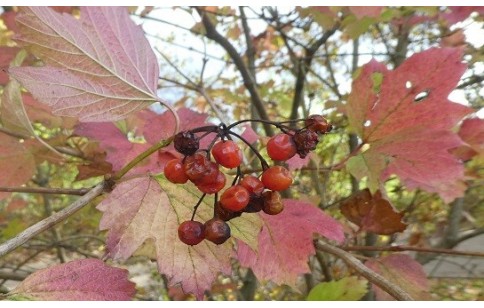- Code : #1057 S 10 mg
- Formula : C₃₀H₁₈O₁₀
- CAS : 1617-53-4
Viburnum opulus
Viburnum opulus, “Guelder rose” in English and “Viorne obier” in French, belongs to the Adoxaceae botanical family. Native to Europe and north and west Asia, it is a shrub or small tree growing to 5 m in hedges, scrub, woodland and swamps.
The plant has an ancient cultural importance in Eastern Slavic countries and is one of the national symbols of Russia. The raw fruit is slightly toxic but edible once cooked although very bitter, used in Eastern traditional cuisine and as a cranberry substitute.
The bark, leaves and fruit are traditionally used as a drug for different ailments: cough, asthma, colds, tuberculosis, rheumatic aches, ulcers, stomach and kidney problems, diabetes, hypertension, hemorrhoids etc.
Among the main bioactive components are phenolic compounds, vitamin C, carotenoids, iridoids and essential oils. The main volatile constituents in the fruits are alcohols, terpenoids, phenols, ketones, aldehydes, esters, branched fatty acids, and other acids.

- Code : #0016 S 10 mg
- Formula : C₃₀H₅₀O
- CAS : 559-70-6
- Code : #0976 S 20 mg
- Formula : C₁₅H₁₄O₆
- CAS : 154-23-4
- Code : #0977 S 20 mg
- Formula : C₁₅H₁₄O₆
- CAS : 490-46-0
- Code : #0502 1 g
- Formula : C₉H₆O₄
- CAS : 305-01-1
- Code : #4838 S 20 mg
- Formula : C₁₃H₁₈O₇
- CAS : 138-52-3
- Code : #0558 S 20 mg
- Formula : C₁₀H₈O₄
- CAS : 92-61-5








